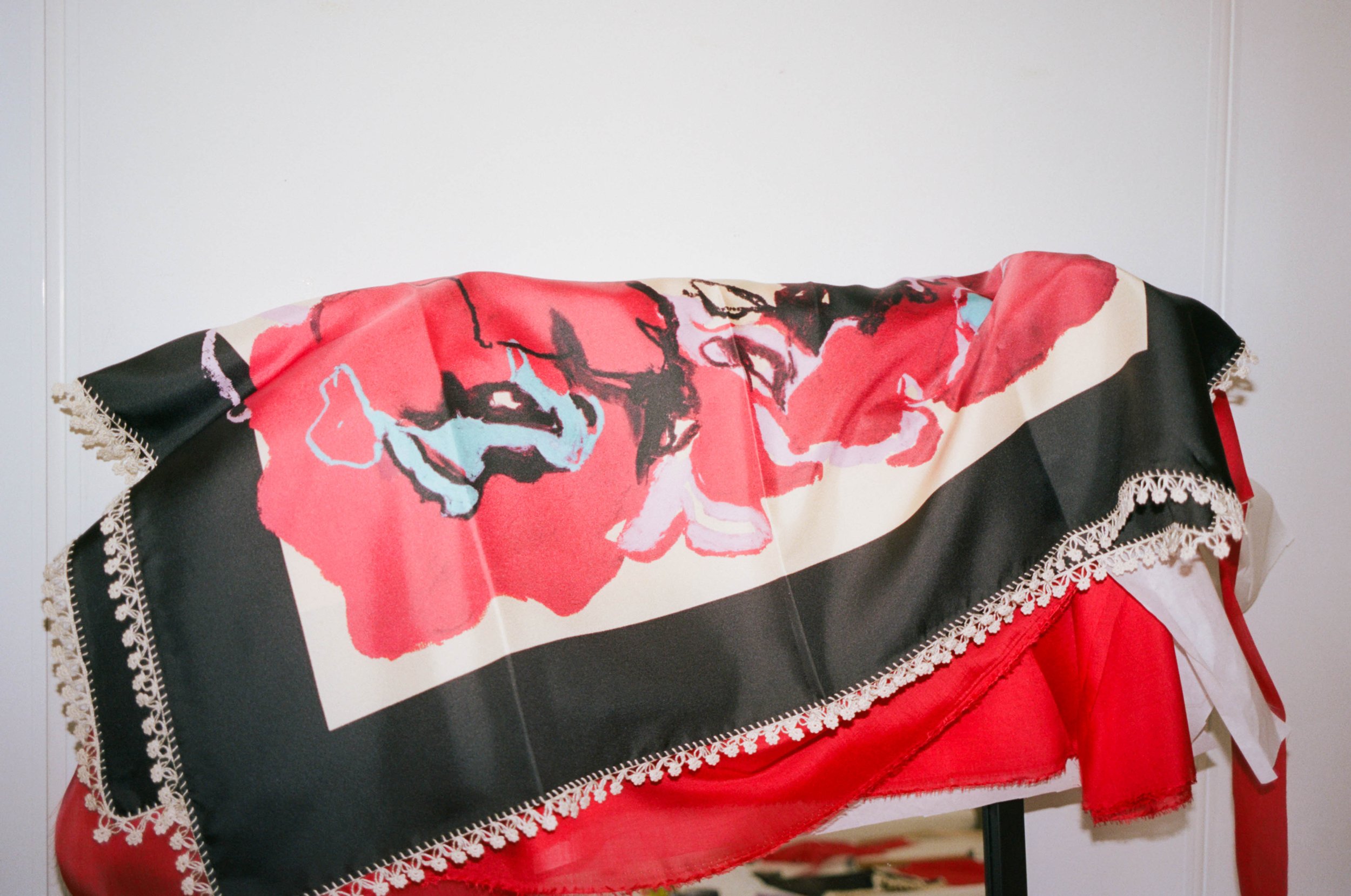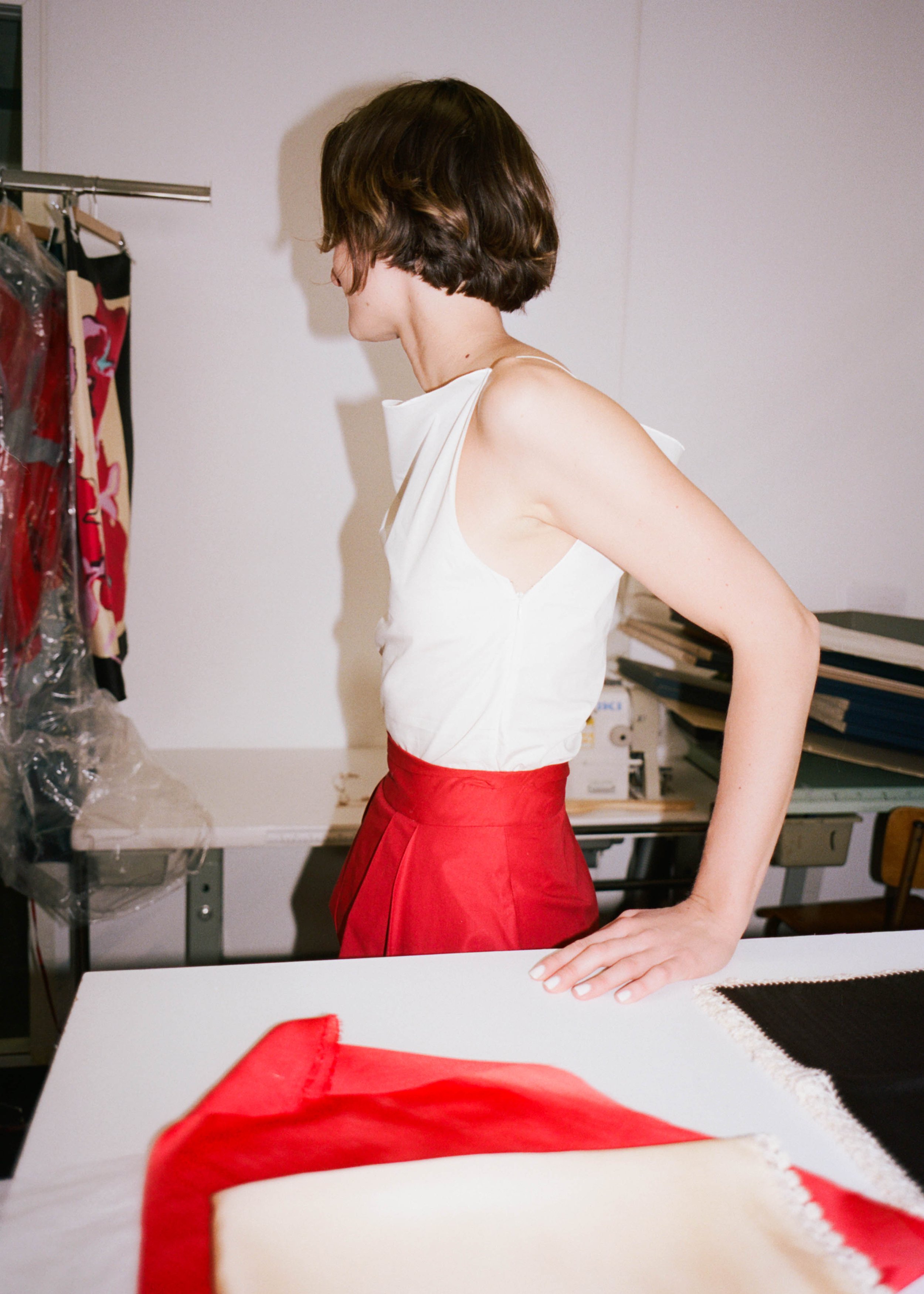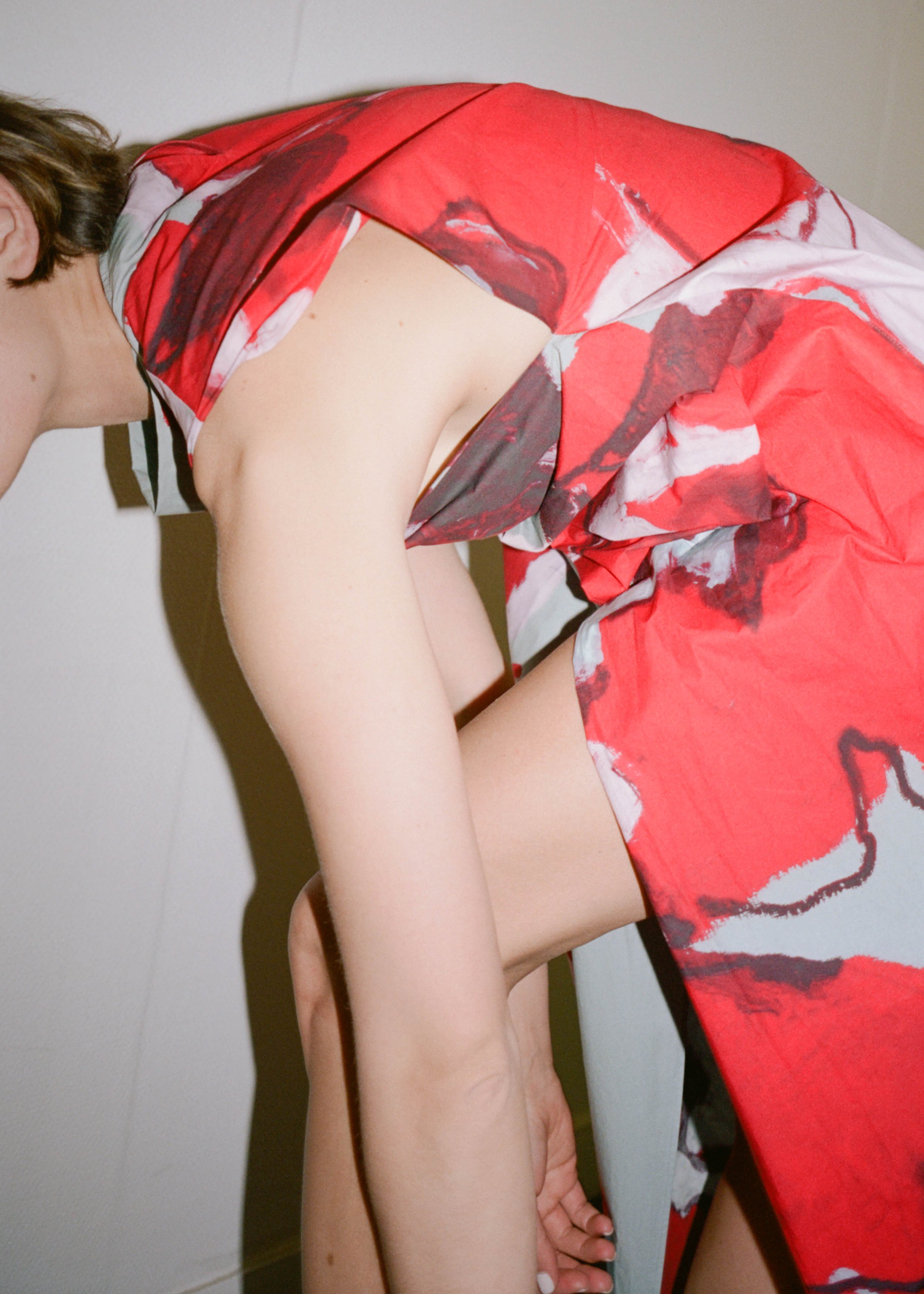ADF ‘In Praxis’ Interviews
The Emotive Strength of a Needle and Thread:
Designer Sera Oltan’s Archival Reattribution in Istanbul and Paris
In the historic quarter of Nicosia, Cyprus, one can find the house of dragoman Hadjigeorgakis Kornesios, who served as the official interpreter for the Divan (Council) of the Sultan for thirty years from 1779. The mansion is now an immaculately conserved ethnographic museum, showcasing fine, block-printed ‘mandilia’ or head scarves composed of richly dense vegetal dyes. Representing gender, status, and familial associations, the scarves spoke in symbolic ways that produced a resistant visual language of communication. A mode of dress that discreetly evaporated, the craft and ethos of the headscarves are threatened by the loss of the esteemed master artisans, replaced by the advent of technology.
Months later after visiting Hadjigeorgaki’s house, ADF Founder Katerina Papanikolopoulos met the Trabzon-born designer Sera Oltan of Sera Studio during a trip to Paris. Trabzon’s history is deeply enriched by Greek heritage and protagonists – founded in classical antiquity as a Greek trading colony, its name hails from the ancient Greek ‘Trapezous’. Later, located at the far northeastern corner of Anatolia, it was the longest surviving of the Byzantine successor states. Pontic Greek is still spoken in the region, forming a vastly diverse pedigree of interchange across the cultural sectors through language.
Embodying the diverse character of the port city – craft, design and symbolic vestiges traversed borders at the same velocity. The mandilia in the collections of the Hadjigeorgaki’s house bear traces of oya, a form of delicate needle lace used as a border traditionally crafted by women across the Near East. In Greek, ‘bebilla’ defines the small or delicate lace edging mirroring the term oya. Variants in coloration and the floral motifs used by the women describe age and stages of life – with the purple hyacinth symbolizing love while roses, jasmine, and carnations were reserved for marriage and young women. Historically, although oya was a woman’s craft, men’s headdresses in the Aegean during Ottoman rule first adopted the garment edging.
INTRODUCING SERA
Oltan’s encounters with the textile collections of her grandmother, both made and sourced, informed her early tactile vocabulary of laces, broderies, and oya scarves and served as the basis for the inherent character of her vision. Her historical ties to the region crystallized into new territories of making after she studied both in New York (Parson School of Design) and Paris (Institut Français de la Mode). By collaborating with artisans to recreate and simplify the floral border crochet technique while applying it to silk scarves and theatrical garment forms, Oltan revives the collective history of oya scarves, and adjacently, the Greek-Cypriot mandili. In the process, Oltan inspires a canonical shift in how contemporary praxis may redefine and conserve generations of makers’ philosophies, exceeding the precedent and transitioning the aesthetic and novel history of the garment.
ADF orchestrated an opportunity to peer inside the Paris atelier, within the infrastructure of Plateau Urbain, alongside Ecuadorian and NYC-based photographer Andrés Altamirano and model Olia Varda. Papanikolopoulos speaks to the designer on her use of photographic archives, the collecting and reimagining of the oya scarves, and the conscious reattribution of a woman’s role in extending a legacy through craft.
––––
ADF – Sourcing of Oya Scarves and The Inherited Craft of Woodblock Printing
The anthropological research into the way women used and created them. In the village of Tokat – where does the tradition continue? Are there craft councils in place?
Tokat is a well-known city for its woodblock printing technique, which is separate from the oya embroidery technique. The woodblock prints often found on the oya embroidered scarves are called “yazma” and can be applied to scarves but also to bed and table linens or fabrics for clothing. In former times, the traditional apple motif printed scarves were even used as invitations to weddings. The woodblock printing, historically, would have been made in an artisan atelier in Tokat. The motifs of the wood blocks have a story of their own, given by the artisans who carved them. They are, however, less open to interpretation, especially for the more traditional motifs, as they all originate from Tokat and the interpretations of these motifs became a shared knowledge.
Woodblock printing involves many steps from carving the wood, to the transfer of the block to the fabric, to painting inside the motif, to the final step of drying. The motifs were usually carved of wood blocks from lime, walnut, and plum trees and that process alone was a craft that required a mastery of its own.
This skill is still preserved, but the industrial style digital printing, unfortunately, did take over for bigger productions. So, the yazma technique stays more of a local craft in the city of Tokat. Luckily there is a continuous effort to keep this know-how alive, including the appearance of some new generation ateliers who experiment to repurpose old motifs as well as some older artisans who continue since generations. There are also some cooperatives that provide workshops. I hope to visit Tokat soon and collaborate with artisans there to incorporate this wonderful know-how into future editions.
ADF – How have both France and Türkiye influenced you? Has architecture been incorporated into your research? How about the colors of Istanbul...the deep red we see so clearly in your designs? The historical red of Istanbul…The traditional dyes and the use of plant fibers?
I left Istanbul when I was 18, having lived in Istanbul only from 13 years old and onwards. I was born and raised in the city of Trabzon in the northeast. Both those places inspired me in different ways. Trabzon inspired me in terms of crafts, as it was a place where museums were hard to find and the creation happened on the streets, from basket weavers to copper making. Istanbul, on the other hand, inspired me with its sentimental, sometimes nostalgic stories and alluring scenery. A city, always moving, a chaotic place of unexpected harmony with extraordinary spirit and its people from many places, ideas, and beliefs. Paris inspired me in terms of the importance of know-how in garment making as well as the art of dressing, the appreciation of the classic, the timeless. All of those things come together differently in my work either through color, technique, and spirit. Edition I, for example, draws on the red color of the streets in Istanbul whereas Edition III, is inspired by the water and the sea, which were always within eye reach in Trabzon and Istanbul, and its tranquility has always soothed me.
ADF – Expand on your collaborations with contemporary artists / printmakers - is it perhaps a conscious way to continue women's role in storytelling?
My work is about preserving and passing on the stories of traditional crafts but also looking for new perspectives to represent them while doing so. Working with a community of women creatives who can do that while creating their own narratives has an undeniable value in reshaping the contemporary landscape of storytelling while establishing a bond between generations. While working with the embroiderer Kumru Mısırlıoğlu for the creation of the oya edgings in my hometown of Trabzon, it was wonderful to collaborate with the painter Ana Karkar in Paris who reinterpreted the traditional yazma motifs in her contemporary vision for the prints. Therefore, it was possible to present something very historic through both traditional and modern interpretations at the same time. I am now working for edition III, with the French-Lebanese painter Christine Safa, in a new print collaboration, where she pictured the Mediterranean landscape we share within different geographies with the continuous sentiment of longing towards it, which I am very excited to share soon.
ADF – The strength of archives illuminate Sera, how have photographers such as Bill Ray influenced you? We are able to visualize Türkiye evolving throughout time...where does Sera stand today?
Research is a big part of my process and one of the mediums that interest me the most is photography. It's very visual and its context is usually broader than the moment it depicts, but also because it still is open to imagination, a certain interpretation that can change from one viewer to the next.
I look at different photographers' work to understand how their views and stories differ. Photographers like Bill Ray and Harry Gruyaert inspire me because their images are also concerned with the aesthetic value and therefore storytelling through their eyes is preeminent. Then, there are photographers who lived in Türkiye or were from Türkiye and their documentation seems different, probably because of their interaction with the people, capturing it from within. Yıldız Moran, Ara Güler, İbrahim Zaman, Sami Güner are some of the many. I also study photographs taken by art historians and researchers, which are a bit less concerned with the aesthetics of the image and more with capturing the people and the crafts for the sake of documentation. My biggest resources are Josephine Powell and Walter B. Denny, as well as the archives of the Salt Research in Istanbul.
I'd like to think that, like the photographs that inspire me and guide me, I would be offering just a gaze into a vast history. My goal is not to present a certain depiction of Türkiye but rather a discovery of the stories that I come across with a focus on crafts, textiles, and the culture of dressing and do my share of passing them on.
ADF: Your favorite museums in Istanbul?
Sadberk Hanım Museum
Ara Güler Museum
İstanbul Museum of Modern Art
SALT
Depo İstanbul
Topkapi Palace Museum
Pera Museum
____
Images Courtesy Andrés Altamirano for Athens Design Forum
Model: Olia Varda















